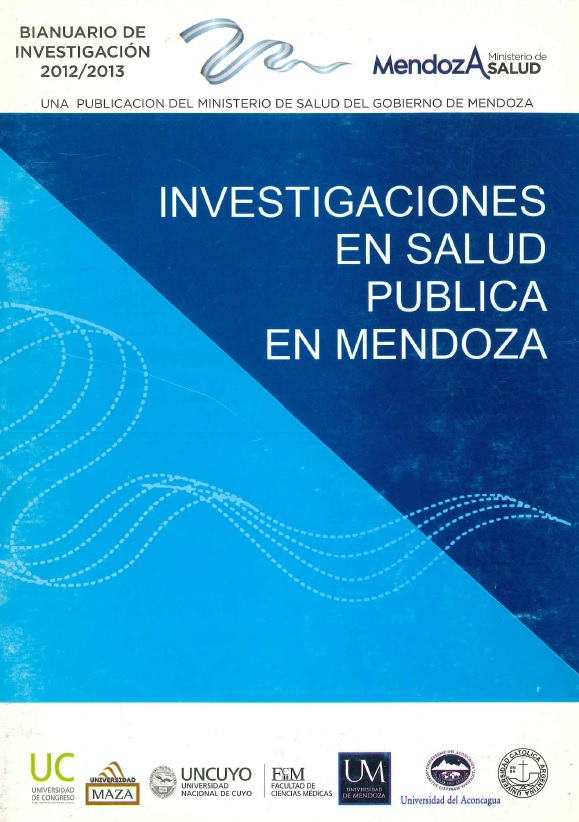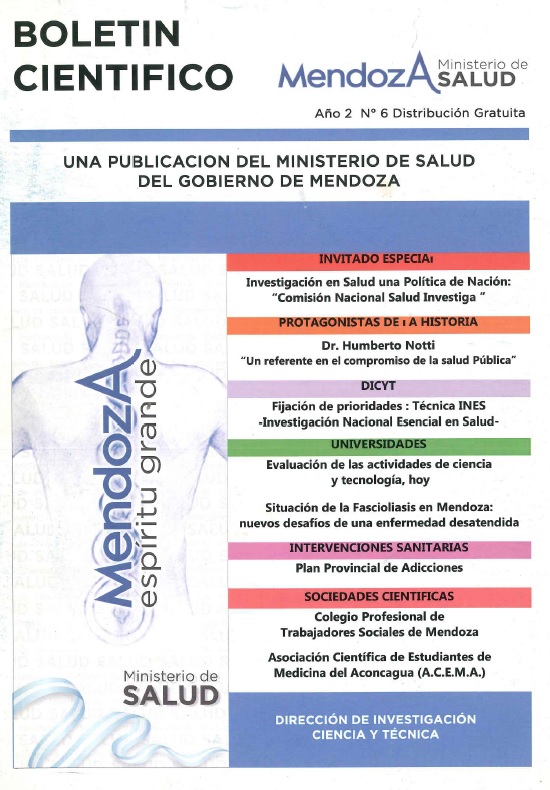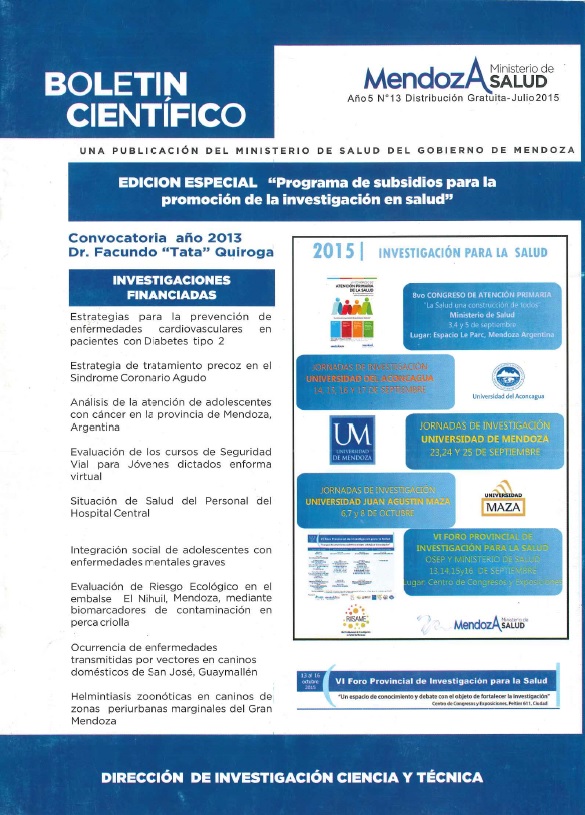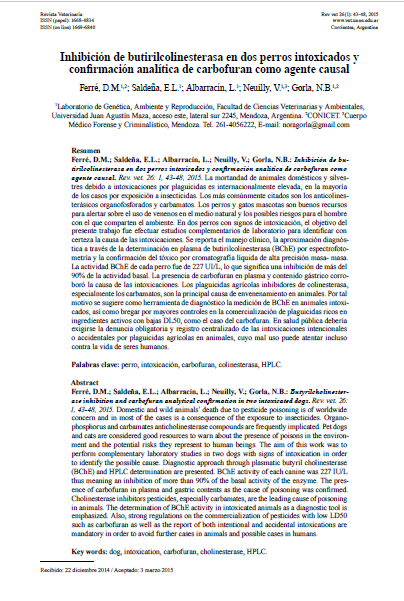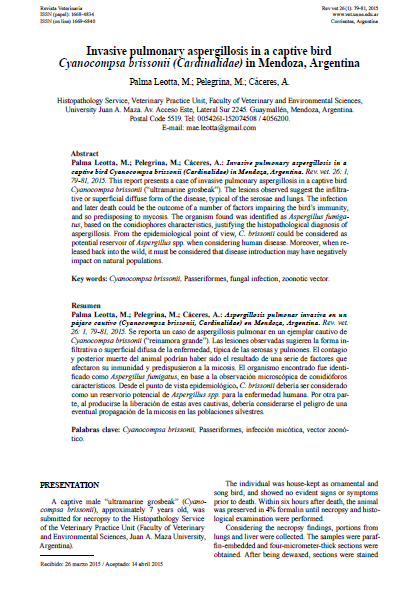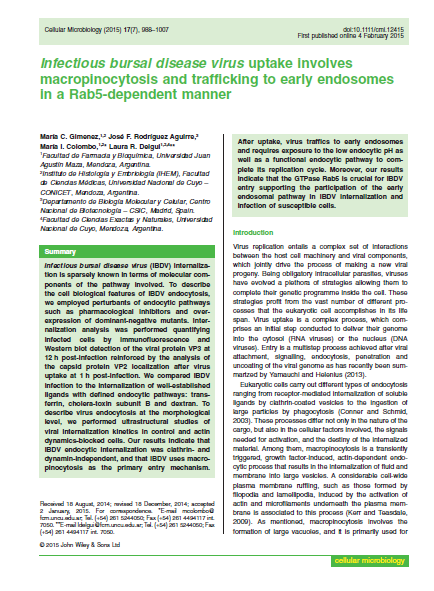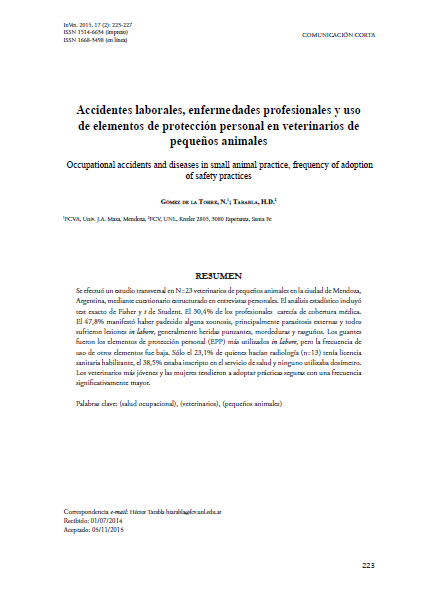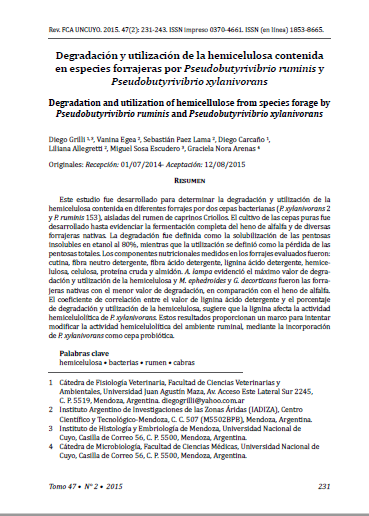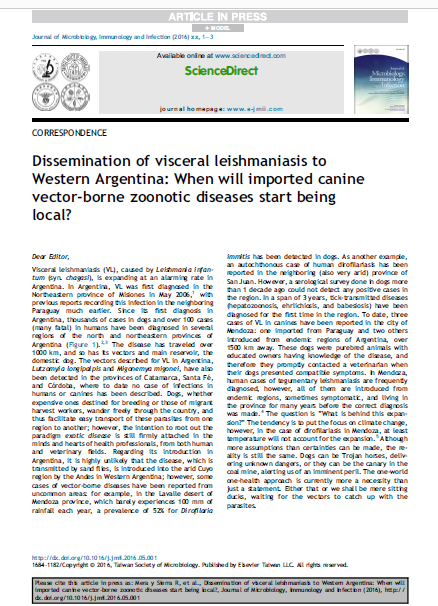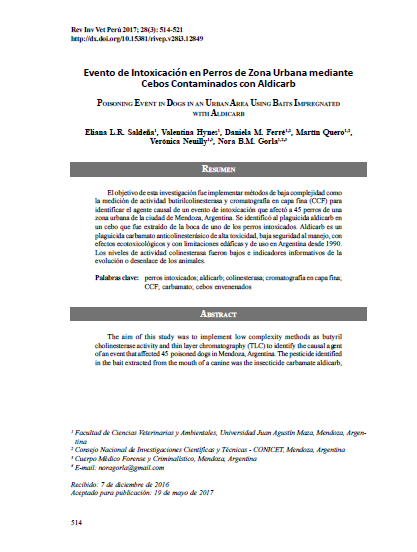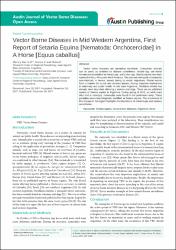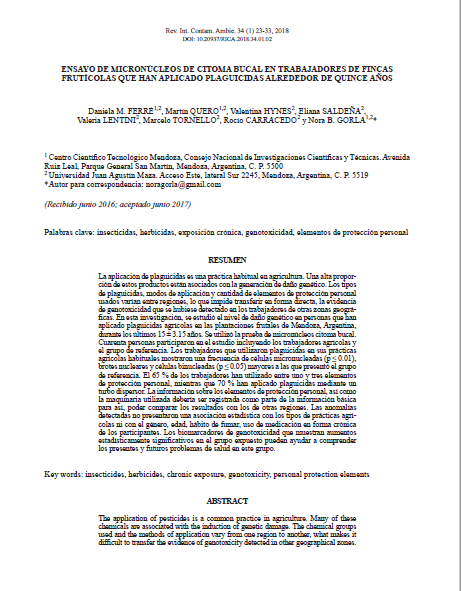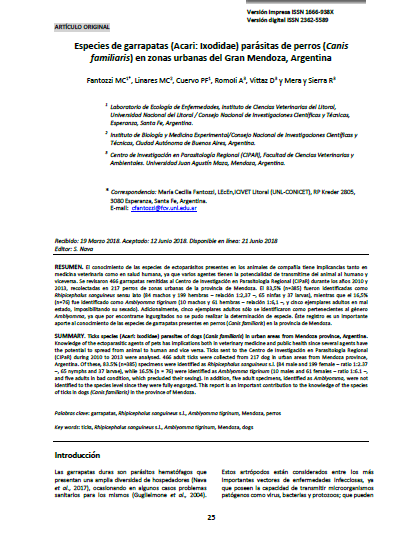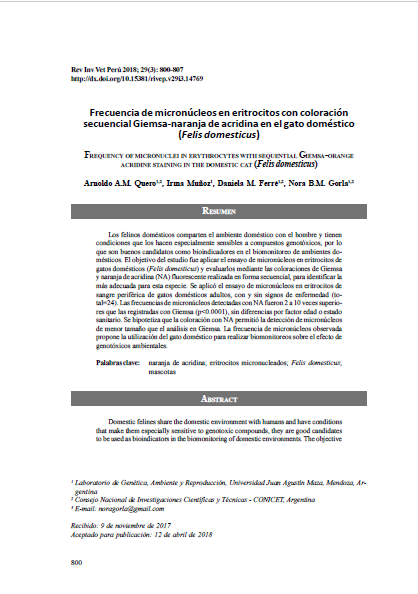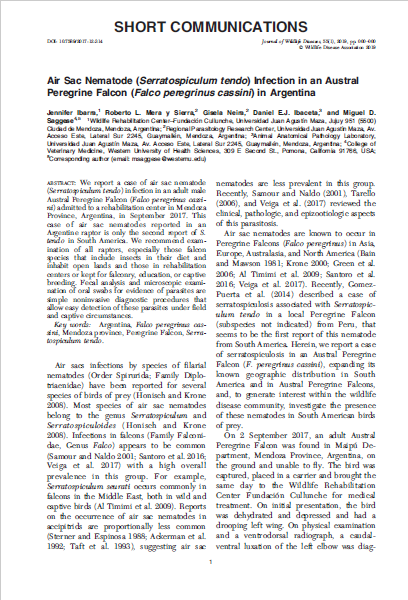Browsing Ciencias Veterinarias by Issue Date
Now showing items 1-18 of 18
-
Aplicación de biología molecular veterinaria: diagnóstico molecular de escherichia coli productor de toxina shiga (STEC) en mascotas de niños con síndrome urémico.
(Dirección de Investigación, Ciencia y Técnica. Ministerio de Salud. Mendoza, 2013)La forma más frecuente del sindrome urémico hemolítico (SUH) en Argentina está asociada a infecciones causadas por STEC, patógeno emergente con presentación endémica en la Argentina. Se registran aproximadamente 400 casos nuevos por año, con una mortalidad del 2,5% al 5% y con una tendencia estacional con mayor incidencia en verano. No existe confirmación de que los animales domésticos son reservorios de cepas STEC. Boletines de la Dirección de Investigación, Ciencia y Técnica del Ministerio de Salud de Mendoza. Los artículos publicados pertenecen a resultados de proyectos UMaza con subsidio ... -
Situación de la fasciolasis en Mendoza: nuevos desafíos de una enfermedad desatendida
(Dirección de Investigación, Ciencia y Técnica. Ministerio de Salud. Mendoza, 2013-03)La fascioliasis es una enfermedad producida por los trematodos Fasciola hepatica y Fasciola gigantica, transmitida por caracoles acuáticos de la familia Lymnaeidae. Tradicionalmente era considerada una enfermedad de importancia veterinaria por el impacto que produce sobre el ganado, únicamente afectando a humanos en forma esporádica. Sin embargo, en años recientes, esta situación ha cambiado en forma drástica: de 2000 casos humanos reportados a nivel mundial entre 1970-1990, actualmente se ven afectados 17 millones de personas y otros 91 millones se encuentran en riesgo. La fascioliasis se ha ... -
Ocurrencia de enfermedades transmitidas por vectores en caninos domésticos de San José, Guaymallén
(Dirección de Investigación, Ciencia y Técnica. Ministerio de Salud. Mendoza, 2015)Las enfermedades transmitidas por vectores (ETV) impactan sobre la salud animal y humana, representando un 17% de las enfermedades infecciosas. Recientemente, por causas diversas, el interés por ellas ha ido en aumento. Consideradas propias de regiones tropicales, se han diseminado ampliamente, emergiendo en regiones templadas. Los animales de compañía no son ajenos a esta realidad: los perros pueden ser reservorio de alrededor de 30 agentes zoonóticos. En caninos, la co-infección por patógenos transmitidos por vectores es frecuente y, a su vez, los vectores (particularmente garrapatas) pueden ... -
Inhibición de butirilcolinesterasa en dos perros intoxicados y confirmación analítica de carbofuran como agente causal
(Comité editorial Revista Veterinaria, Facultad de Ciencias Veterinarias de la Universidad Nacional del Nordeste (UNNE), 2015)La mortandad de animales domésticos y silvestres debido a intoxicaciones por plaguicidas es internacionalmente elevada, en la mayoría de los casos por exposición a insecticidas. Los más comúnmente citados son los anticolinesterásicos organofosforados y carbamatos. Los perros y gatos mascotas son buenos recursos para alertar sobre el uso de venenos en el medio natural y los posibles riesgos para el hombre con el que comparten el ambiente. En dos perros con signos de intoxicación, el objetivo del presente trabajo fue efectuar estudios complementarios de laboratorio para identificar con certeza ... -
Invasive pulmonary aspergillosis in a captive bird Cyanocompsa brissonii (Cardinalidae) in Mendoza, Argentina
(Comité editorial Revista Veterinaria, Facultad de Ciencias Veterinarias de la Universidad Nacional del Nordeste (UNNE), 2015)Se reporta un caso de aspergillosis pulmonar en un ejemplar cautivo de Cyanocompsa brissonii (“reinamora grande”). Las lesiones observadas sugieren la forma infiltrativa o superficial difusa de la enfermedad, típica de las serosas y pulmones. El contagio y posterior muerte del animal podrían haber sido el resultado de una serie de factores que afectaron su inmunidad y predispusieron a la micosis. El organismo encontrado fue identificado como Aspergillus fumigatus, en base a la observación microscópica de conidióforos característicos. Desde el punto de vista epidemiológico, C. brissonii debería ... -
Infectious bursal disease virus uptake involves macropinocytosis and trafficking to early endosomes in a Rab5-dependent manner
(Comité editorial Cellular Microbiology, 2015-01-07)Infectious bursal disease virus (IBDV) internalization is sparsely known in terms of molecular components of the pathway involved. To describe the cell biological features of IBDV endocytosis, we employed perturbants of endocytic pathways such as pharmacological inhibitors and overexpression of dominant-negative mutants. Internalization analysis was performed quantifying infected cells by immunofluorescence and Western blot detection of the viral protein VP3 at 12 h post-infection reinforced by the analysis of the capsid protein VP2 localization after virus uptake at 1 h post-infection. ... -
EFFECT OF THE REARING SYSTEM ON THE ESTABLISHMENT OF DIFFERENT FUNCTIONAL GROUPS OF MICROORGANISM IN THE RUMEN OF KID GOATS
(Comité editorial Acta Veterinaria-Beograd, 2015-06-23)This study was aimed to determine the effect of the rearing system on the establishment and development of different functional groups of microorganisms in the rumen of kid goats. Fifty kids were fed on goat milk until weaning at 45 (TR, traditional rearing system, n = 25) and 30 days of age (alternative rearing system, AR, n = 25). In addition, only AR group was offered with rumen starter from birth. Both groups consumed alfalfa hay and ground corn between 30 and 90 days of age. Five kids from each group were slaughtered at 21, 30, 45, 70 and 90 days old. It was determined the total number of ... -
Accidentes laborales, enfermedades profesionales y uso de elementos de protección personal en veterinarios de pequeños animales.
(Comité editorial InVet, 2015-11-05)Se efectuó un estudio transversal en N=23 veterinarios de pequeños animales en la ciudad de Mendoza, Argentina, mediante cuestionario estructurado en entrevistas personales. El análisis estadístico incluyó test exacto de Fisher y t de Student. El 30,4% de los profesionales carecía de cobertura médica. El 47,8% manifestó haber padecido alguna zoonosis, principalmente parasitosis externas y todos sufrieron lesiones in labore, generalmente heridas punzantes, mordeduras y rasguños. Los guantes fueron los elementos de protección personal (EPP) más utilizados in labore, pero la frecuencia de uso de ... -
Degradación y utilización de la hemicelulosa contenida en especies forrajeras por Pseudobutyrivibrio ruminis y Pseudobutyrivibrio xylanivorans
(Comité editorial Revista de la Facultad de Ciencias Agrarias, 2015-12)Este estudio fue desarrollado para determinar la degradación y utilización de la hemicelulosa contenida en diferentes forrajes por dos cepas bacterianas (P. xylanivorans 2 y P. ruminis 153), aisladas del rumen de caprinos Criollos. El cultivo de las cepas puras fue desarrollado hasta evidenciar la fermentación completa del heno de alfalfa y de diversas forrajeras nativas. La degradación fue definida como la solubilización de las pentosas insolubles en etanol al 80%, mientras que la utilización se definió como la pérdida de las pentosas totales. Los componentes nutricionales medidos en los ... -
Dissemination of visceral leishmaniasis to Western Argentina: When will imported canine vector-borne zoonotic diseases start being local?
(Comité Editorial Journal of Microbiology, Immunology and Infection, 2015-12-15)Visceral leishmaniasis (VL), caused by Leishmania infantum (syn. chagasi), is expanding at an alarming rate in Argentina. In Argentina, VL was first diagnosed in the Northeastern province of Misiones in May 2006,1 with previous reports recording this infection in the neighboring Paraguay much earlier. Since its first diagnosis in Argentina, thousands of cases in dogs and over 100 cases (many fatal) in humans have been diagnosed in several regions of the north and northeastern provinces of Argentina (Figure 1).2,3 The disease has traveled over 1000 km, and so has its vectors and main reservoir, ... -
Evento de Intoxicación en Perros de Zona Urbana mediante Cebos Contaminados con Aldicarb.
(Comité editor Revista de Investigaciones Veterinarias del Perú, 2017-05-19)El objetivo de esta investigación fue implementar métodos de baja complejidad como la medición de actividad butirilcolinesterasa y cromatografía en capa fina (CCF) para identificar el agente causal de un evento de intoxicación que afectó a 45 perros de una zona urbana de la ciudad de Mendoza, Argentina. Se identificó al plaguicida aldicarb en un cebo que fue extraído de la boca de uno de los perros intoxicados. Aldicarb es un plaguicida carbamato anticolinesterásico de alta toxicidad, baja seguridad al manejo, con efectos ecotoxicológicos y con limitaciones edáficas y de uso en Argentina desde ... -
Vector Borne Diseases in Mid Western Argentina, First Report of Setaria Equina [Nematoda: Onchocercidae] in A Horse [Equus caballus]
(Comité editorial Austin Journal of Vector Borne Diseases, 2017-12-05)Vector borne diseases are spreading worldwide. Companion animals can be useful as sentinels for disease surveillance. Setaria spp. are filarial nematodes transmitted by Aedes spp. and Culex spp. Setaria equina has been reported in Asia, Africa and North America. This zoonotic nematode is frequently asymptomatic in horses, except during its erratic migrations. Filarial worms have a tropism for ocular and nervous tissues, having important implications in veterinary and public health. In mid west Argentina, Dirofilaria immitis has already been described affecting a woman and dogs. There are no ... -
Ensayo de micronúcleos de citoma bucal en trabajadores de fincas frutícolas que han aplicado plaguicidas alrededor de quince años.
(Comité editorial Revista internacional de contaminación ambiental, 2018-02)La aplicación de plaguicidas es una práctica habitual en agricultura. Una alta proporción de estos productos están asociados con la generación de daño genético. Los tipos de plaguicidas, modos de aplicación y cantidad de elementos de protección personal usados varían entre regiones, lo que impide transferir en forma directa, la evidencia de genotoxicidad que se hubiese detectado en los trabajadores de otras zonas geográficas. En esta investigación, se estudió el nivel de daño genético en personas que han aplicado plaguicidas agrícolas en las plantaciones frutales de Mendoza, Argentina, durante ... -
Especies de garrapatas (Acari: Ixodidae) parásitas de perros (Canis familiaris) en zonas urbanas del Gran Mendoza, Argentina.
(Comité editorial Revista FAVE – Sección Ciencias Veterinarias, 2018-06-21)El conocimiento de las especies de ectoparásitos presentes en los animales de compañía tiene implicancias tanto en medicina veterinaria como en salud humana, ya que varios agentes tienen la potencialidad de transmitirse del animal al humano y viceversa. Se revisaron 466 garrapatas remitidas al Centro de Investigación en Parasitología Regional (CIPaR) durante los años 2010 y 2013, recolectadas en 217 perros de zonas urbanas de la provincia de Mendoza. El 83,5% (n=385) fueron identificadas como Rhipicephalus sanguineus sensu lato (84 machos y 199 hembras – relación 1:2,37 –, 65 ninfas y 37 larvas), ... -
Frecuencia de micronúcleos en eritrocitos con coloración secuencial Giemsa-naranja de acridina en el gato doméstico.
(Comité editorial Revista de Investigaciones Veterinarias del Perú, 2018-09)Los felinos domésticos comparten el ambiente doméstico con el hombre y tienen condiciones que los hacen especialmente sensibles a compuestos genotóxicos, por lo que son buenos candidatos como bioindicadores en el biomonitoreo de ambientes domésticos. El objetivo del estudio fue aplicar el ensayo de micronúcleos en eritrocitos de gatos domésticos (Felis domesticus) y evaluarlos mediante las coloraciones de Giemsa y naranja de acridina (NA) fluorescente realizada en forma secuencial, para identificar la más adecuada para esta especie. Se aplicó el ensayo de micronúcleos en eritrocitos de sangre ... -
Air Sac Nematode ( Serratospiculum tendo) Infection in an Austral Peregrine Falcon ( Falco peregrinus cassini) in Argentina.
(Comité editorial Journal of Wildlife Diseases, 2019-01)We report a case of air sac nematode (Serratospiculum tendo) infection in an adult male Austral Peregrine Falcon (Falco peregrinus cassini) admitted to a rehabilitation center in Mendoza Province, Argentina, in September 2017. This case of air sac nematodes reported in an Argentine raptor is only the second report of S. tendo in South America. We recommend examination of all raptors, especially those falcon species that include insects in their diet and inhabit open lands and those in rehabilitation centers or kept for falconry, education, or captive breeding. Fecal analysis and ... -
A Single Nucleotide Polymorphism Translates into a Radical Amino Acid Substitution at the Ligand-Binding Site in Fasciola hepatica Carboxylesterase B
(Comite editorial GENES, 2022-10-19)Fasciola hepatica anthelmintic resistance may be associated with the catalytic activity of xenobiotic metabolizing enzymes. The gene expression of one of these enzymes, identified as car boxylesterase B (CestB), was previously described as inducible in adult parasites under anthelmintic treatment and exhibited a single nucleotide polymorphism at position 643 that translates into a radical amino acid substitution at position 215 from Glutamic acid to Lysine. Alphafold 3D models of both allelic sequences exhibited a significant affinity pocket rearrangement and different ligand-docking modeling ... -
Host drivers of canine dirofilariosis in an arid environment of western Argentina
(Parasitology Research, 2024-10-09)Canine dirofilariosis is a mosquito-borne zoonotic disease largely caused by Dirofilaria immitis. Mainly present in temperate, semitropical, and tropical areas, its worldwide emergence and spread are causing concern. In Argentina, most cases have been reported in humid regions of the center and northeast of the country. The occurrence of canine dirofilariosis in an arid environment of western Argentina was investigated by blood smears, microhematocrit tube test, and Knott’s technique. Association and odds ratio were determined in relation to dog characteristics. Thirty-three dogs (51.6%) had ...







